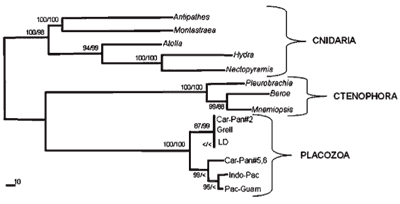Mysterious Trichoplax
BioEssays regularly runs a feature called "My Favorite Animal"; this month's choice is barely an animal at all, the placophoran Trichoplax adhaerens. I've written about Trichoplax before. It's a strange creature, a small flat blob that creeps amoeba-like over the substrate, that replicates by simply splitting in two, and that seems to have no distinguishing features at all—no head, no sense organs, no nervous system, no gut, just a collection of cells that hang together and slurp up algal slime. They are, however, multicellular, and their bodies contain at least four functionally distinct cell types, and the molecular evidence suggests affinities to other animal groups (they have a ProtoHox/ParaHox gene, for instance)…so they are definitely metazoans. They are just the simplest, barest kind of metazoan we can find now.
As a thin disc with no polarity other than which side sticks to the substrate and which faces the open water, Trichoplax has provocative appeal as a representative of an ancient multicellular form—a creature that has clustered cells together to grow larger, has taken the first steps towards specializing cells for digestion and protection, but hasn't even achieved pre-worm status. It's the kind of pre-Cambrian browser from which our own line might have evolved. Here's a simple and speculative (but not at all outrageous) idea of how this could have occurred:
Placula hypothesis of metazoan evolution. Flagellated protozoans unite to form a benthic-vagile, plate-like metazoan organism. The one-layered protist form (a) evolves to the two-layered "placula" (b,c). Cells of the upper layer form the ectoderm, while cells of the lower layer (orange) adopt a nutritive function and later invaginate to form the entoderm (d-g)
Trichoplax represents an intermediate grade of organism, one which has learned the trick of maintaining multiple cell types in specific roles and how to organize them into a spatially patterned relationship, but has not established any other kind of polarity—it doesn't know its head from its ass, and actually has neither one of those sophisticated features. At this point, it's an intensely mysterious organism, and there are many things we simply don't know about it. That is one of the many provocative things about this animal, things that draw scientists to it in fascination.
- We don't know how many species of Trichoplax there are. It lacks distinguishing morphological characters, obviously enough, and molecular/genetic tests of animals collected in the Red Sea and the Sea of Japan have found them to be indistinguishable. A single species seems to have a world-wide distribution, yet other analyses have found distinct differences between different strains.
- We know nothing of their ecology. Samples are collected and grown in the lab for study, but what exactly these nearly invisible animals do in the wild is unknown.
- As a developmental biologist, I'm most puzzled by their modes of reproduction. In the lab, they are known to reproduce solely by vegetative division—the animal just splits in two, and two placozoans crawl away. However, they've also been known to produce motile sperm and eggs, which fail to produce viable offspring in the lab…they just die. Do they reproduce sexually only under certain very specific conditions in the wild, or is sexual reproduction a fading vestige of a primitive condition they are in the process of abandoning?
Where I find these creatures particularly interesting, though, is how they may help answer questions about evolution and development.
There is a concept in evolution that many people find hard to grasp: that is, new genes and new functions do not evolve out of any "need" for a new property. Instead, genes that have one role may be coopted into a new role by fortuitous ancillary properties. For instance, the set of genes that are involved in early longitudinal patterning in us chordates, that is, that help define which end of an embryo should form a head and which end should form a tail, are the Hox genes. It would be a mistake to argue that these genes arose in order to specify the head end of an animal, though—the first animals to have these genes would not have had a head! That primordial Hox-like gene must have had some other function, a function which could be easily modified by chance to localize to just one end of the animal, an event which would have been crucial in defining anterior-posterior polarity and turning a blob into a worm.
What would that function have been? How can we find out?
The strategy is to look for animals that do not form heads, but do have Hox-like genes, and ask what they use them for…animals like Trichoplax. They do have a gene called Trox-2 which is in the Hox gene family, and we can examine where it is being expressed in Trichoplax. It is expressed in scattered cells around the margin of the animal, seen as the pink dots in A, below:
The study of regulatory genes reveals insights into basic and basal mechanisms of metazoan development and evolution. Most regulatory genes studied so far are expressed within or close to a small region of potentially undifferentiated cells embedded between the lower and the upper epithelium. A,B: Trichoplax whole mount in situ hybridization for the putative ProtoHox/ParaHox gene, Trox-2; note the strong and homogenous expression close to the body margin; arrows in B point to small undifferentiated—yet undescribed—cells between the lower and upper epithelium. C,D: Trichoplax whole mount in situ hybridization for the putative ProtoPax gene, TriPaxB; note the more spotted expression along the body margin; the arrow in D points to a small TriPaxB-expressing cell that is similar to cells expressing the Trox-2 gene.
The gene seems to be active in a pool of undifferentiated cells, which are not localized to one end, but are instead found in a ring. It is a kind of spatial localization; a change in gene regulation that involved a loss of expression over a part of its range would lead to an asymmetry that could be a precursor to defining an anterior-posterior axis.
It's more than just a single gene. Other genes similar to patterning genes found in more complex metazoans have also been identified: the gene Pax B is illustrated above and is also present in a ring, and genes related to Not, the T-Box class, and antp have been found. There is a whole network of regulatory gene interactions present in these marginal cells, a network that was a precursor to the more restricted networks we possess that are responsible for giving us a head and a more sophisticated form than a disc-like blob.
This represents another successful evolutionary prediction. What we expect to find in biology is that the networks of genes responsible for specific morphological features in complex organisms will also be present in simpler forms, but with broader, more general, and sometimes rather different functions. With Trichoplax, we're identifying the evolutionary foundations of some of the most basic features of our embryonic organization—features so primitive that we take them entirely for granted.
Schierwater B (2005) My favorite animal, Trichoplax adhaerens. BioEssays 27:1294-1302.



Fascinating! An organism that has evolved to occupy a local evolutionary maximum (a 'Hill improbable'), and whose genotype has no easy route to further development, or an organism that is an intermediate step to something more complex? (I'm not a biologist, as may be evident to those who are from my first sentence!) Presumably something like this does not fossilize, so we have no idea how far back this goes?